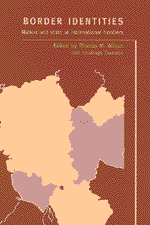Book contents
- Frontmatter
- Contents
- List of maps
- List of contributors
- Acknowledgements
- 1 Nation, state and identity at international borders
- 2 State formation and national identity in the Catalan borderlands during the eighteenth and nineteenth centuries
- 3 A western perspective on an eastern interpretation of where north meets south: Pyrenean borderland cultures
- 4 The ‘new immigration’ and the transformation of the European-African frontier
- 5 Transnationalism in California and Mexico at the end of empire
- 6 National identity on the frontier: Palestinians in the Israeli education system
- 7 Grenzregime (border regime): the Wall and its aftermath
- 8 Transcending the state? gender and borderline constructions of citizenship in Zimbabwe
- 9 Borders, boundaries, tradition and state on the Malaysian periphery
- 10 Markets, morality and modernity in north-east Turkey
- 11 Imagining ‘the South’: hybridity, heterotopias and Arabesk on the Turkish–Syrian border
- Author index
- Subject index
6 - National identity on the frontier: Palestinians in the Israeli education system
Published online by Cambridge University Press: 02 December 2009
- Frontmatter
- Contents
- List of maps
- List of contributors
- Acknowledgements
- 1 Nation, state and identity at international borders
- 2 State formation and national identity in the Catalan borderlands during the eighteenth and nineteenth centuries
- 3 A western perspective on an eastern interpretation of where north meets south: Pyrenean borderland cultures
- 4 The ‘new immigration’ and the transformation of the European-African frontier
- 5 Transnationalism in California and Mexico at the end of empire
- 6 National identity on the frontier: Palestinians in the Israeli education system
- 7 Grenzregime (border regime): the Wall and its aftermath
- 8 Transcending the state? gender and borderline constructions of citizenship in Zimbabwe
- 9 Borders, boundaries, tradition and state on the Malaysian periphery
- 10 Markets, morality and modernity in north-east Turkey
- 11 Imagining ‘the South’: hybridity, heterotopias and Arabesk on the Turkish–Syrian border
- Author index
- Subject index
Summary
Introduction
Barth's concern, a generation ago, with the extent to which ethnic groups have boundaries (Barth 1969) has developed into a preoccupation with the extent to which cultures have borders and borders have culture(s). The boundaries of culture and the relationship of culture to territory are most significantly debated in the discourse of transnationalism, where enquiries into creolisation and hybridisation in border areas (Anzaldua 1987, Rosaldo 1988) have led to studies of diasporas (Clifford 1994, Boyarin and Boyarin 1993), and other interstitial phenomena. The initial tendency among anthropologists to look at border situations from the point of view of members of the marginal minority has also been supplemented by an enquiry into the perspective of the dominant majority (Rabinowitz 1994a).
The discourse of transnationalism is based on a productive critique of the inherent imperfections of traditional representations of nations, states and cultures as geographically discrete and politically pacific. It suggests a radically different definition of space and occupancy in which entities other than those defined by, contained within, or tantamount to states and nations become significant elements of the human experience.
The concept of the border zone – a place where, as Jon Simons (1995) put it, no one ever feels at home – challenges the primacy in Western culture of discrete borders and rigid boundaries. But while constantly moving away from this rigidity, the discourse of transnationalism remains dialectically dependent on it.
- Type
- Chapter
- Information
- Border IdentitiesNation and State at International Frontiers, pp. 142 - 161Publisher: Cambridge University PressPrint publication year: 1998
- 5
- Cited by



